Reimagined Story
Submission to Survivals, Ruptures, Resiliences: Perspectives from Disability Scholarship, Activism, and Art
Kelly O’Neil
missionkelly [at] yahoo [dot] ca
COMMENTARY
On my 57th birthday, I visited the Bodies in Translation: Age and Creativity exhibit at Mount Saint Vincent University Art Gallery in Halifax. The installation featured creative work by a group of Maritimes-based artists exploring the dimensions of aging and age-based disability. Described as an examination of “aging and the artistic process,”1 the exhibit offered a counterpoint to ageist views in its framing of aging bodies as beautiful, interesting, and valid. Having recently returned to school full-time to begin a master’s degree in Family Studies and Gerontology, I savored a few hours away from a busy schedule. Wandering slowly through the works and listening to what the artists had to say about their projects in recorded commentaries offered a lovely sojourn into the imaginations of other people.
Although I have a background in social work, I am new to the field of gerontology and the world of long-term care. Having worked with residents of homeless shelters and prisons, I’ve thought a lot about how we as a society create the spaces to which we consign other people. This interest is reflected in my thesis exploring the experiences of low income older women in accessing secure housing. I’m looking at the issue through a feminist lens, which considers, among other things, how social constructions of gender impact a woman’s ability to find a safe and affordable place to live.
I had been feeling challenged in my new exposure to gerontology. I was seeing that we socially construct “old people” in many ways that are similar to how we construct ideas of “homeless people” or “offenders.” My brother once described a process from his days as a corporate executive in which management with perceived performance issues were earmarked for pending dismissal. He said that first, they got “red circled”—that is, metaphorically demarcated and increasingly excluded from important processes and decisions as a prelude to firing. This strategy continued until the employee’s visible isolation and apparently growing irrelevance led to a dismissal that seemed like a natural and appropriate outcome.
This idea got me thinking about how a similar process of red circling takes place in human society where those whose performance is designated as substandard, less than, or aberrant get marked for removal to places like homeless shelters and correctional facilities. I was recognizing the same kind of red circling of older adults in literature that positioned aging persons fundamentally as objects of care—reductionist views of individuals with deep and complex personal histories as targets of assessment, surveillance, and control. I was disturbed by how the idea of “risk management” can get used as a catch-all rationalization for institutionalizing older adults.
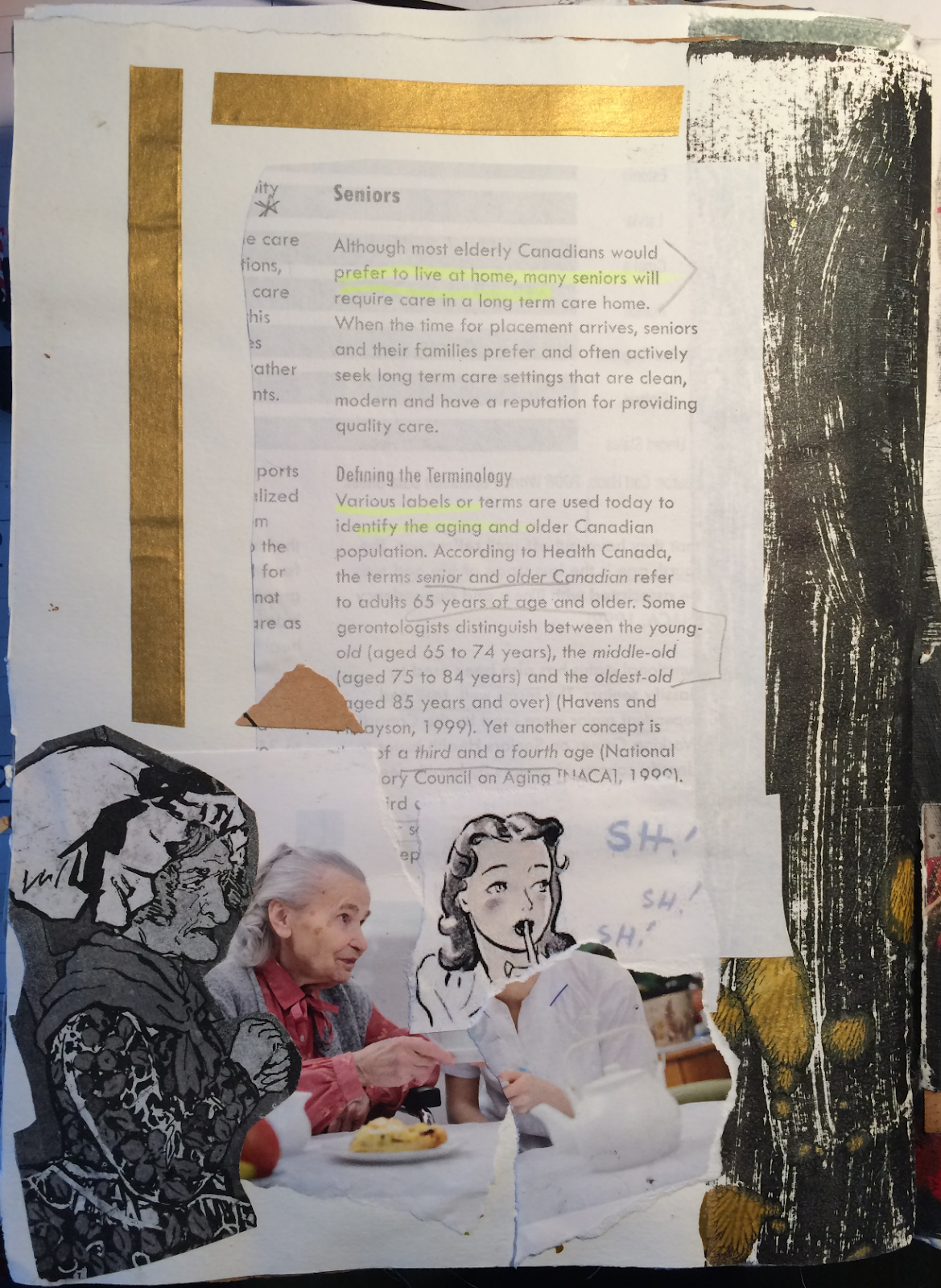
The Bodies in Translation: Age and Creativity exhibit provided a welcome counter-narrative to such one-dimensional thinking about people and the process of aging, and I was grateful for it: grateful to be reminded of “the presence of different minds and bodies”2 (grateful, at least for a different way of reading those minds and bodies, which, like mine, resisted imposed understandings). Photographer George Steeves’ Nude in West Street Kitchen challenged the notion of human beauty as exclusive to the domain of youth. His joyful subject, resplendent in her robust, lived-in body, revealed a dignity and power seldom associated with older persons. While looking at this picture, I thought about how the concealment of older bodies suppresses and denies that power. MJ Sakurai’s witty video exploration of sexuality and older adults invited the viewer to consider ways in which the “life force sensual energy”3 of aging bodies is made manifest. A life missed—the absence of a treasured older family member—was poignantly expressed in a blank embroidery panel with its relinquished needle and thread in Anna Torma’s Red Fragments 2017. [Images of works and descriptions available via http://artintranslation.ca]
I emerged from the gallery with a sense of exhilaration and creative energy I hadn’t felt for a long time. I was inspired and emboldened by artist Karen Langlois’ altered book, A Story, with its beautifully reorganized and re-interpreted text. This work was, to me, a moving and elemental statement of how discourses can be examined, challenged, and revised. I was equally energized by Dr. Eliza Chandler’s understanding of art’s “radical potential…to disrupt normative practice.” 2 That inspiration led to the creation of my own reconstructed book using a series of collages as a means of both reflecting on my life experiences and of challenging narratives about the meaning of growing older. I submitted the book as part of a personal map project for a course on critical theory.
For my reconstructed book, I chose a number of experiences from my own life that have shaped the person I am, the person who is now, in my late 50s, designated as an older woman. Several markers on my trajectory to old age were considered as a lens through which to explore the feminist assertion that the ‘personal is political’. These markers include the experiences of being a professional “caregiver,” of interacting with the medical system as a menopausal woman, of being sexually assaulted as a teenaged girl, of being a woman without children, and of being seen by others as an old/er person. Coming to terms with the construction of women as caregivers has meant a lifelong search for a comfortable place between imposed expectations and my own inclinations. The medicalized, hegemonic ideology of the problematic uterus4 deeply impacted my experience of the significant life transition of menopause. The ramifications of normalized violence against women continue to be a backdrop for my, and many women’s, everyday experience. And now, approaching 60, I join the ranks of aging women everywhere who move forward into old age with stigmatized and derided old bodies.5 Nonetheless, I resist being red circled.

From the time I was a child, I was drawn to making collages. I think I intuitively recognized the power contained in tearing up ideas and images and reconstituting them in ways that made sense to me. I see collage making as the beginning of a revolutionary process of the mind, where scissors and glue become elemental instruments of resistance. I picked up the book used in this project, an Old Mother Hubbard reader, at a flea market. The pages were literally falling apart in my hands. The idea of interweaving new ideas into an old and crumbling book featuring an iconic crone seemed an appropriate medium for a critical exploration of my experiences as an aging woman. My reconstructed book collages text and images from the original children’s reader with material extracted from the media, the internet, long term care promotional pamphlets, research sources, and ink prints I made on a homemade press.
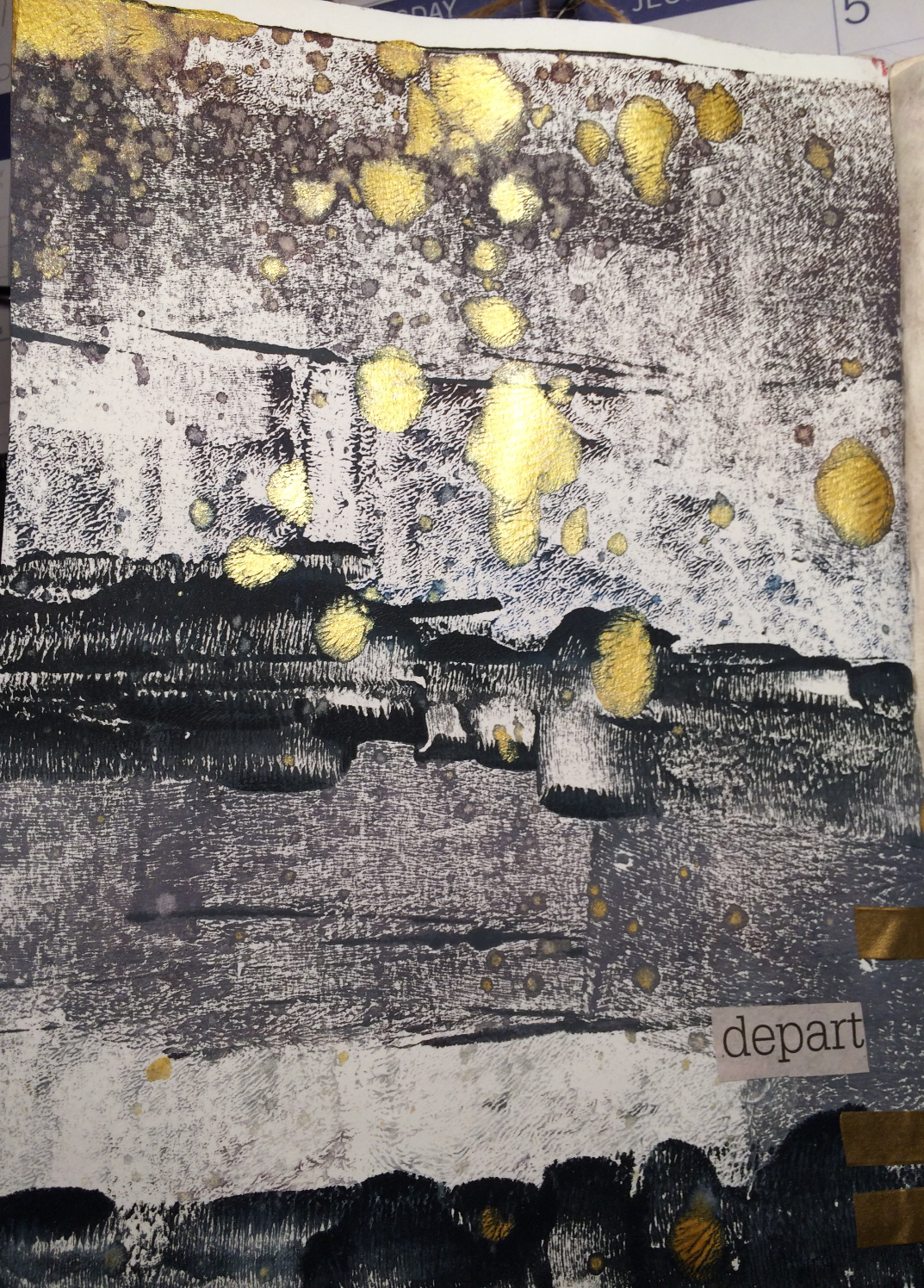
I like to use the word resistance rather than resilience when talking about responses to inequitable systems. The word resilience gets too easily mixed up with valorizing people for their “heroic” accomplishments while effectively diverting attention from the structures that shape the barriers they face. I think the term resistance privileges people’s innate capacity to challenge imposed limitations. I’m curious about how resistance and art might be further explored among aging women. How can our unique identities and social locations be used to disrupt imposed norms about what it means to be a woman growing old within ageist and sexist social and political contexts? What might a refusal to be red circled look like for older women? What are some taken-for-granted assumptions about us that need to be torn up and reimagined as stories that talk about who we are?
References
- Chandler, E. (n.d.). Curatorial statement from Bodies in translation: Age and creativity. MSVU Art Gallery.
- Chandler, E. (2017, September). Creatively engaging: disability arts, aesthetics and accessibility. Public lecture, Halifax Central Library.
- Sakurai, M.J. (2017). Artist’s statement, Vintage plumbing and wiring 2010. In Bodies in translation: Age and creativity. MSVU Art Gallery.
- Loppie, C., & Keddy, B. (2002). A feminist analysis of the menopause discourse. Contemporary Nurse, 12(1), 92-99 .doi.org/10.5172/conu.12.1.92
- Calasanti, T., Slevin, K.F., & King, N. (2006). Ageism and feminism: From “et cetera” to center. NWSA Journal, 18(1), 13–30. https://doi.org/10.2979/nws.2006.18.1.13
Figure 2: Images from Age and Creativity Exhibition
Bodies in Translation: Age and Creativity Organized by MSVU Art Gallery, Bodies in Translation and the Nova Scotia Centre on Aging with financial support from the Canada Council for the Arts and SSHRC
Eliza Chandler, Lindsay Fisher and Ingrid Jenkner, Curators
9 September through 12 November 2017
All images: photo Steve Farmer
Link to ASL description of exhibition: http://artintranslation.ca/about-the-exhibition/

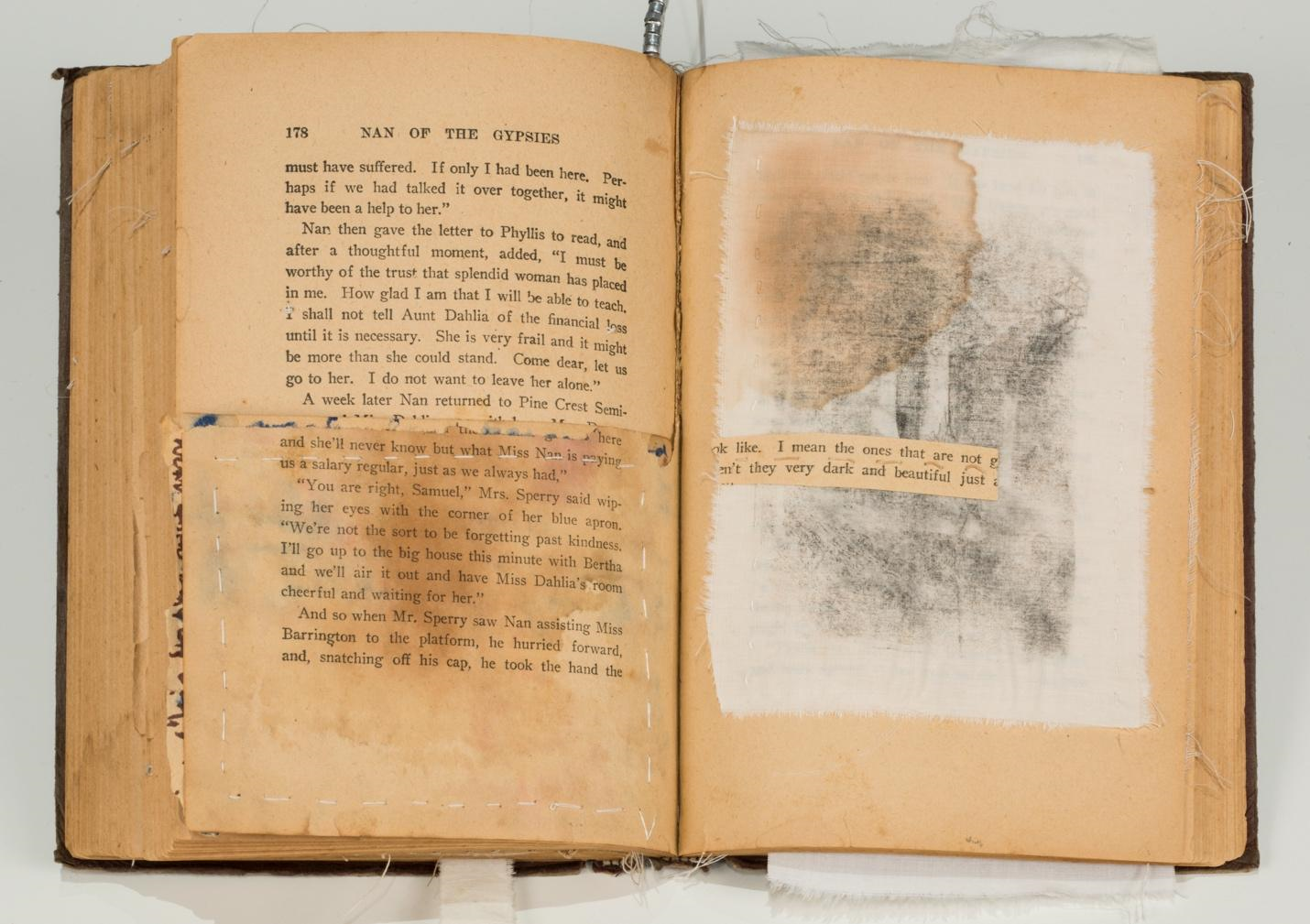
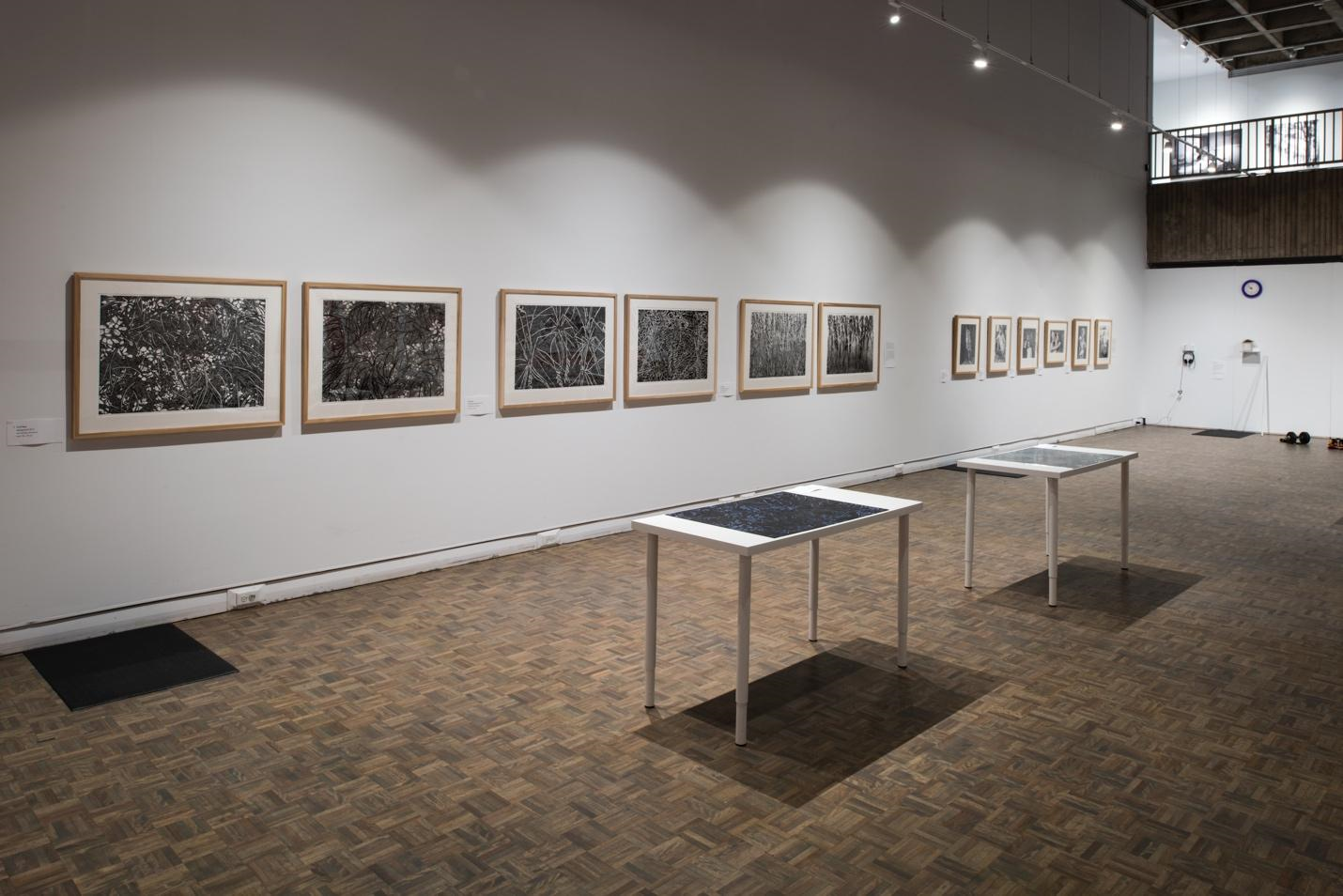
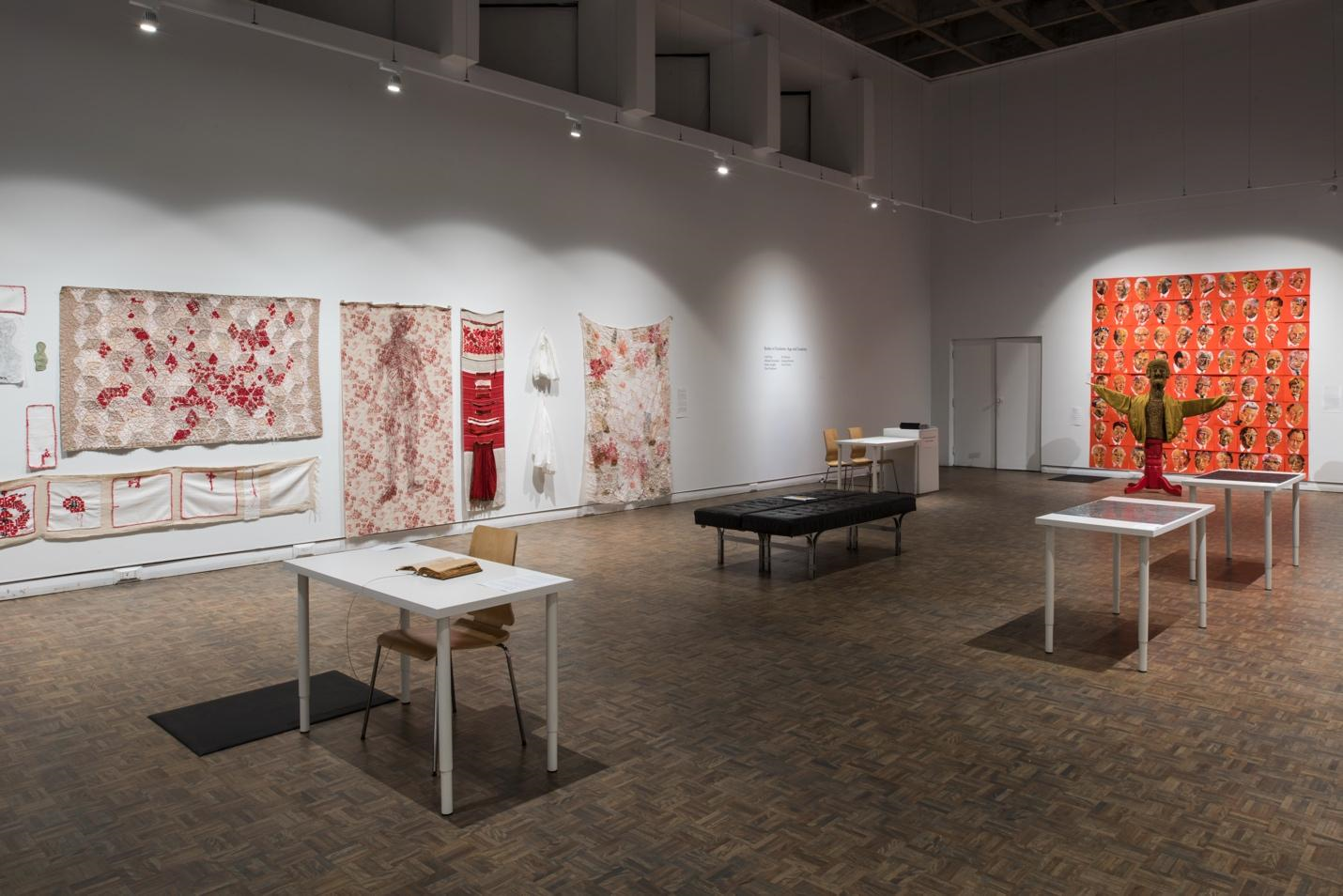
Verbal Descriptions of Collages- Text for Audio Recording
Defining the Terminology
This collage, called Defining the Terminology, contains torn fragments of paper with images and text layered together on top of an ink print I made. The print is visible along the right vertical side of the collage beneath the text and images. The print, on thick, rough paper, is black with splotches of gold. At the bottom left hand side of the page, there are collaged images of three women. These images were torn or cut from separate source documents, and I’ve reassembled them so that the three characters appear to be seated together at a nursing home breakfast table. All three characters are looking off to the right, into the darkness. The images are of Mother Hubbard, which was taken from a children’s book. She looks a bit cross and weary. To her right, there is a woman in her 70s or 80s wearing a pink blouse and a grey vest who is seated next to a nurse. This photograph was taken from a long term care pamphlet. The nurse’s head in the image has been replaced by a 1940s style cartoon head of woman with her finger to her lip, saying “Sh! Sh! Sh!” These pieces are overlaid on an excerpt from a text in Gerontology. The text reads in part, “Various labels or terms are used today to identify the aging and older Canadian population”. The text then proceeds to review some of these terms. I was imagining what it would be like if these women came together to resist and redefine these labels, which are pasted behind them as a background. Seated together as they are, they seem to be plotting something. Like an escape, perhaps.
Dysfunctional System
I named this collage Dysfunctional System. It describes my experiences accessing health care as a menopausal woman. The collage contains a mix of re-worked text and pictures stacked on top of each other. The bottom layer contains a description of a gynecological medical procedure. On top of these words, I’ve pasted a phrase reconstituted from the words “Mother Hubbard”. It read “Hubba Hubba”—a catcall to women from another era. A 1940s-style cartoon woman saying “Sh! Sh! Sh!” reappears here, reminding everyone that menopause is not something women are supposed to talk about. Below the words “Hubba Hubba” is an image from what seems like an old textbook showing a sketch of a uterus. This image contains the words “The reproductive system” and “Uterus (womb) and shows a stick pointing at the uterus. The images selected here are all intentionally old-fashioned. They represent thinking that should be outdated but somehow isn’t—especially the fact that women’s biology is so often sexualized. Pasted on top and to the right of the uterus image is a square panel from my own graphic journal. The image is a cartoon of a personified, misshapen uterus (she has eyes and a mouth) and a bunch of labels pointing to different areas, suggesting various diagnoses of her “problem.” The uterus looks pretty freaked out. Underneath are the words, “They think I need to have a hysterectomy.” I developed the uterus character as a counterpoint to my experiences accessing medical care. In one sense, the uterus character is taking on other people’s ideas about being messed up, but at the same time she’s challenging and resisting the intrusiveness and limitations of these labels.
Alternative Responses
This collage shows a print I made of the Acadian dykelands in the Annapolis Valley of Nova Scotia. The print shows a very roughly outlined landscape in the background in black and gray ink with splotches of gold ink at the top of the page. The gold ink splotches are randomly arranged and seem to be falling from above, like snow. Toward the bottom right of the paper is the word, “depart” snipped from a newspaper article. The dykes were originally built by the Acadians to reclaim farmland from the sea, and were close to the site of their expulsion by the British in the 18th century. My father was Acadian, and although I don’t speak the language, I have always felt connected to this heritage and story of displacement. I walked along the dykelands everyday for awhile. It became a place of deep peace, calm, and restoration for me. The word “depart” is a reminder that I can return to this place, literally or metaphorically, when I need to get away from things for awhile, to reclaim myself. I see this as a kind of resistance also.